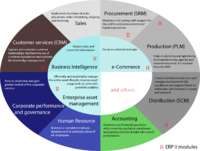
Photo from wikipedia
Integrating active power curtailment (APC) of renewable energy sources (RES) in power system planning reduces necessary investments in the power system infrastructure. In current target grid planning methods, APC is… Click to show full abstract
Integrating active power curtailment (APC) of renewable energy sources (RES) in power system planning reduces necessary investments in the power system infrastructure. In current target grid planning methods, APC is considered by fixed curtailment factors without considering the provided flexibility to its full extent. Time-series-based planning methods allow the integration of the time dependency of RES and loads in power system planning, leading to substantial cost savings compared to the worst-case method. In this paper, we present a multi-year planning strategy for high-voltage power system planning, considering APC as an alternative investment option to conventional planning measures. A decomposed approach is chosen to consider APC and conventional measures in a long-term planning horizon of several years. The optimal investment path is obtained with the discounted cash flow method. A case study is conducted for the SimBench high-voltage urban benchmark system. Results show that the time-series-based method allows for reducing investments by up to 84% in comparison to the worst-case method. Furthermore, a sensitivity analysis shows the variation in total expenditures with changing cost assumptions.
Journal Title: Energies
Year Published: 2020
Link to full text (if available)
Share on Social Media: Sign Up to like & get
recommendations!